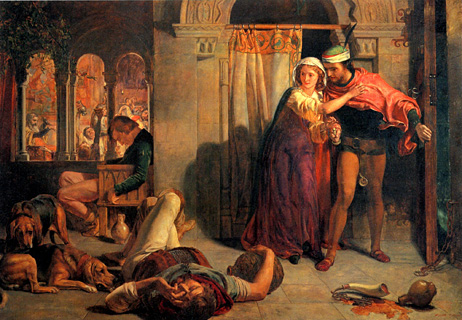Today being St Agnes Eve, this week’s picture is William Holman Hunt’s The Flight of Madeline and Porphyro during the Drunkenness Attending the Revelry. The painting illustrates the penultimate stanza of Keats’s poem, The Eve of St Agnes, in which the two young lovers elope from under the noses of Madeline’s drunken clansmen, sworn enemies of Porfiro and all his family, after a night of boistrous revelry:
“They glide, like phantoms, into the wide hall;
Like phantoms, to the iron porch, they glide;
Where lay the porter, in uneasy sprawl,
With a huge empty flagon by his side.
The wakeful blood hound rose, and shook his hide,
But his sagacious eye an inmate owns;
By one, and one, the bolts full easy slide: –
The chains lie silent on the footworn stones: –
The key turns, and the door upon its hinges groans.”
Hunt was only twenty years old when he painted the picture, which was his first submission to the Royal Academy’s annual exhibition and which, as might be expected, cost him much toil and anxiety. X-rays and preparatory sketches show that he altered the composition frequently, starting for example with the tiptoeing lovers on the left- rather than right-hand side of the canvas, where they finished up, and only deciding at the last minute to include Madeline’s drunken kinsmen, seen carousing in the background through the triple-arched window. In this last detail, Hunt knowingly departed from Keats’s poem, according to which everyone in the castle had fallen into a drunken stupor by the time the lovers made their break for freedom. By conflating the revels with the escape, he was able to give his picture a dramatic tension which it might otherwise have lacked. He also did this to point up the moral contrast which, with...

ITP 92: The Flight of Madeline and Porphyro during the Drunkenness Attending the Revelry, by William Holman Hunt
20-01-2002

